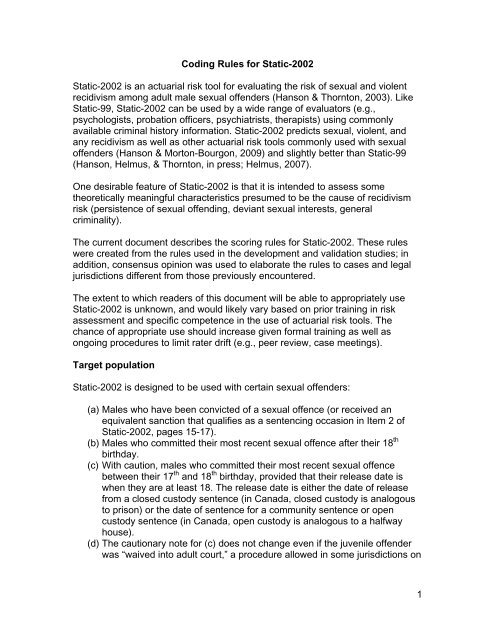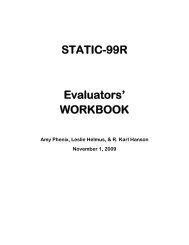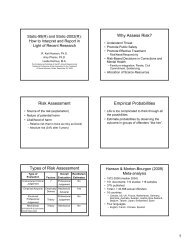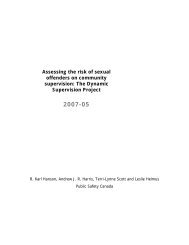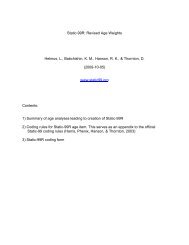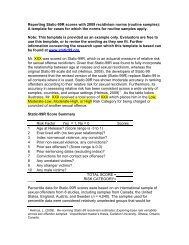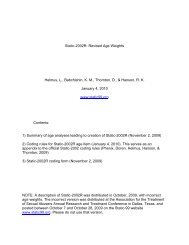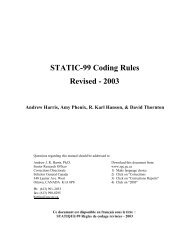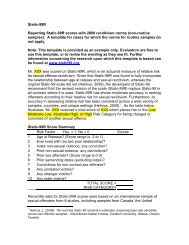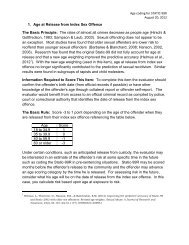Static-2002 coding rules (2009) - Static-99
Static-2002 coding rules (2009) - Static-99
Static-2002 coding rules (2009) - Static-99
You also want an ePaper? Increase the reach of your titles
YUMPU automatically turns print PDFs into web optimized ePapers that Google loves.
Coding Rules for <strong>Static</strong>-<strong>2002</strong><br />
<strong>Static</strong>-<strong>2002</strong> is an actuarial risk tool for evaluating the risk of sexual and violent<br />
recidivism among adult male sexual offenders (Hanson & Thornton, 2003). Like<br />
<strong>Static</strong>-<strong>99</strong>, <strong>Static</strong>-<strong>2002</strong> can be used by a wide range of evaluators (e.g.,<br />
psychologists, probation officers, psychiatrists, therapists) using commonly<br />
available criminal history information. <strong>Static</strong>-<strong>2002</strong> predicts sexual, violent, and<br />
any recidivism as well as other actuarial risk tools commonly used with sexual<br />
offenders (Hanson & Morton-Bourgon, <strong>2009</strong>) and slightly better than <strong>Static</strong>-<strong>99</strong><br />
(Hanson, Helmus, & Thornton, in press; Helmus, 2007).<br />
One desirable feature of <strong>Static</strong>-<strong>2002</strong> is that it is intended to assess some<br />
theoretically meaningful characteristics presumed to be the cause of recidivism<br />
risk (persistence of sexual offending, deviant sexual interests, general<br />
criminality).<br />
The current document describes the scoring <strong>rules</strong> for <strong>Static</strong>-<strong>2002</strong>. These <strong>rules</strong><br />
were created from the <strong>rules</strong> used in the development and validation studies; in<br />
addition, consensus opinion was used to elaborate the <strong>rules</strong> to cases and legal<br />
jurisdictions different from those previously encountered.<br />
The extent to which readers of this document will be able to appropriately use<br />
<strong>Static</strong>-<strong>2002</strong> is unknown, and would likely vary based on prior training in risk<br />
assessment and specific competence in the use of actuarial risk tools. The<br />
chance of appropriate use should increase given formal training as well as<br />
ongoing procedures to limit rater drift (e.g., peer review, case meetings).<br />
Target population<br />
<strong>Static</strong>-<strong>2002</strong> is designed to be used with certain sexual offenders:<br />
(a) Males who have been convicted of a sexual offence (or received an<br />
equivalent sanction that qualifies as a sentencing occasion in Item 2 of<br />
<strong>Static</strong>-<strong>2002</strong>, pages 15-17).<br />
(b) Males who committed their most recent sexual offence after their 18 th<br />
birthday.<br />
(c) With caution, males who committed their most recent sexual offence<br />
between their 17 th and 18 th birthday, provided that their release date is<br />
when they are at least 18. The release date is either the date of release<br />
from a closed custody sentence (in Canada, closed custody is analogous<br />
to prison) or the date of sentence for a community sentence or open<br />
custody sentence (in Canada, open custody is analogous to a halfway<br />
house).<br />
(d) The cautionary note for (c) does not change even if the juvenile offender<br />
was “waived into adult court,” a procedure allowed in some jurisdictions on<br />
1


